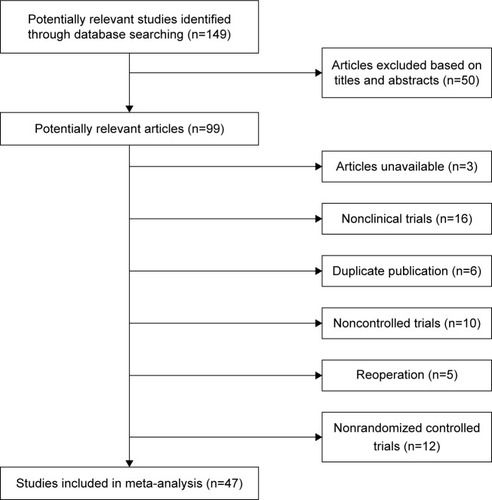Abstract
Purpose
To investigate whether carbon nanoparticles (CNs) are helpful in identifying lymph nodes and metastatic lymph nodes and in parathyroid protection during thyroid cancer surgery.
Methods
English and Chinese literature in PubMed, Cochrane Database of Systematic Reviews, EMBASE, ClinicalTrials.gov, China Biology Medicine Database, China National Knowledge Infrastructure, China Master’s and Doctoral Theses Full-Text Database, Wanfang database, and Cqvip database were searched (till March 22, 2016). Randomized controlled trials (RCTs) that compared the use of CNs with a blank control in patients undergoing thyroid cancer surgery were included. Quality assessment and data extraction were performed, and a meta-analysis was conducted using RevMan 5.1 software. The primary outcomes were the number of retrieved central lymph nodes and metastatic lymph nodes, and the rate of accidental parathyroid removal.
Results
We obtained 149 relevant studies, and only 47 RCTs with 4,605 patients (CN group: n=2,197; blank control group: n=2,408) met the inclusion criteria. Compared with the control group, the CN group was associated with more retrieved lymph nodes/patient (weighted mean difference [WMD]: 3.39, 95% confidence interval [CI]: 2.73–4.05), more retrieved metastatic lymph nodes (WMD: 0.98, 95% CI: 0.61–1.35), lower rate of accidental parathyroid removal, and lower rates of hypoparathyroidism and hypocalcemia. However, the total metastatic rate of the retrieved lymph nodes did not differ between the groups (odds ratio: 1.13, 95% CI: 0.87–1.47, P=0.35).
Conclusion
CNs can improve the extent of neck dissection and protect the parathyroid glands during thyroid cancer surgery. And the number of identified metastatic lymph nodes can be simultaneously increased.
Introduction
Thyroid cancer is a common malignant tumor, and its occurrence has been increasing appreciably over the last few decades.Citation1,Citation2 Papillary thyroid carcinoma, the most common pathological type of thyroid carcinoma, is associated with an excellent prognosis if surgery is performed successfully.Citation3,Citation4 However, complications and tumor metastasis often occur postoperatively. A multicenter revisit study of 25,634 patients with a history of ambulatory surgery revealed that the incidence of hypocalcemia was as high as 20.8%.Citation5 Moreover, the rate of postoperative cervical lymph node metastasis has been reported to be as high as 20%–90%.Citation6,Citation7 Therefore, an effective method is urgently required to help identify and remove additional lymph nodes and decrease the risk of parathyroid injury.
Nanobiotechnology, a new field defined as biomedical applications of nanosized systems, which involves nanostructure and nanomaterials, has emerged as a key player among various disciplines of biomedical science. Nanomaterials, which measure 1–1,000 nm, have unique physical and chemical properties such as small-size effect, large surface area, high reactivity, and quantum effects. In addition, they have been certified as breaking a new ground in disease detection,Citation8,Citation9 imaging,Citation10,Citation11 diagnosis,Citation12,Citation13 and treatment.Citation12,Citation14–Citation16 Carbon-based nanoparticles are an important part of nanomaterials; they include carbon nanotubes, fullerene, and graphene and its derivatives.Citation17 Due to their unique physical and chemical properties, carbon-based nanoparticles have broad applications in the biomedical field. Above all, structure or surface modifications of carbon-based nanoparticles result in different effects.
In recent years, with the development of nanotechnology, nanomaterials or nanosized products have been used in surgeries. Carbon nanoparticles (CNs) suspension (China Food and Drug Administration approval H20041829; Lai Mei Pharmaceutical Co, Chongqing, People’s Republic of China), which comprises nanosized polymeric carbon granules with an average diameter of 150 nm (),Citation18 ensures that these CNs pass through the lymphatic vessels (diameter: 120–500 nm) rather than blood capillaries (diameter: 20–50 nm) due to their molecular size. Hence, the lymph nodes and thyroid glands can be stained with CNs but not the parathyroid glands. Therefore, as revealed in ,Citation19 CNs have been used as lymph node tracers during thyroid surgeries in the People’s Republic of China in recent years, but there is no report about their usage in other countries. Previous studies have demonstrated that CNs could help visualize the lymph nodes and preserve the parathyroid. In addition, a meta-analysis has also been published to support this viewpoint.Citation20 However, controversy still exists about the usefulness of CNs. Liu et al reported that CNs are not beneficial for parathyroid protection during thyroid cancer surgery and that the usage of CNs results in a significantly prolonged operation time.Citation18 Before 2014, all articles published on the usage of CNs in thyroid cancer surgeries were in Chinese, and there were only limited randomized controlled trials (RCTs) reported. Accordingly, a considerable amount of non-RCTs were included in the previous meta-analysis.Citation20 However, in recent years, more RCTs have been published. Hence, another meta-analysis is needed to determine whether CNs are helpful in thyroidectomy.
Figure 1 Transmission electron microscopic image of CNs.
Abbreviation: CN, carbon nanoparticle.
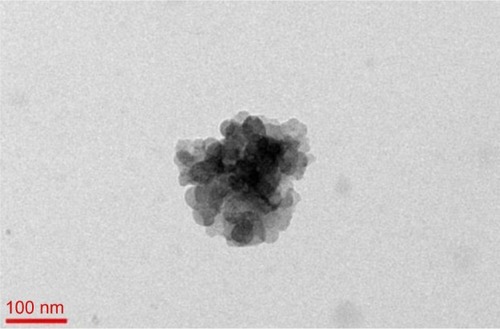
Figure 2 Intraoperative view of the black-stained clusters of lymph nodes by CN injection.
Abbreviation: CN, carbon nanoparticle.

With this in mind, the present systematic review and meta-analysis was designed to confirm whether CNs are indeed helpful in thyroid cancer surgery, that is, whether CNs can really improve the extent of thyroidectomy and neck dissection and help identify metastatic lymph nodes while preserving the parathyroid glands, as compared with the performance of blank controls.
Methods
Search strategy
The following English and Chinese databases were searched systematically by 2 investigators independently (till March 22, 2016): PubMed, Cochrane Database of Systematic Reviews, EMBASE, ClinicalTrials.gov, China Biology Medicine Database, China National Knowledge Infrastructure, China Master’s and Doctoral Theses Full-Text Database, WANFANG database, and Cqvip database. RCTs on initial thyroid cancer surgeries that compared the use of CNs with a blank control were included. Our search terms included (nano-carbon) or (carbon particle) or (carbon nanoparticle) or (carbon nanoparticles) or (lymph node tracer) or (lymphatic tracer) or (lymphography) and (thyroid or thyroidea). To resolve any disagreement between the 2 investigators, a third reviewer was invited to assess any discrepant items.
Inclusion criteria
The studies selected were RCTs on thyroid cancer surgeries that included: 1) patients who underwent initial surgery and with a confirmed pathology diagnosis and 2) a control group not injected with anything before thyroidectomy and a CN group injected with CNs.
Exclusion criteria
Non-independent clinical controlled trials, non-RCTs, studies with a patient number <10, or studies with incomplete data were excluded.
Observation indexes
The primary outcomes were the number of retrieved central lymph nodes and metastatic lymph nodes per patient, and the rate of accidental parathyroid removal. Other outcomes extracted from the identified RCTs included the staining rate of lymph nodes, the number of metastatic lymph nodes in all retrieved lymph nodes, and the rate of postoperative transient or permanent hypoparathyroidism and hypocalcemia. All included articles reported at least 1 of the outcomes.
Quality assessment
To evaluate the quality of these studies, the Jadad scoring system was applied in the RCTs. The scoring system included 3 items: descriptions of the dropouts and withdrawals (0 or 1 point), blinding (0–2 points), and randomization (0–2 points). The maximum score was 5 points. RCTs that scored 3–5 points were considered to be of high quality, whereas a score of 0–2 was considered to indicate low quality.
Statistical analysis
RevMan version 5.1 software was used for the statistical analyses. We measured the heterogeneity of the studies using the I2 and χ2 tests. Statistical heterogeneity of the studies was defined as an I2 value <50% or P-value <0.10. The random-effects model was applied if heterogeneity existed among the studies; otherwise, the fixed-effects model was adopted for the analyses. Weighted mean differences (WMDs) with 95% confidence intervals (CIs) were used for the continuous outcome variables, whereas risk differences (RDs) and odds ratios (ORs) with 95% CIs were calculated for the dichotomous outcome variables. To investigate possible bias, funnel plots were created. For all analyses, statistical differences were considered to exist between the 2 groups when P-value was <0.05.
Results and discussion
Considering the complicated anatomic structure and lymphatic drainage, the cervical lymph node metastasis rate is amazingly high after thyroid cancer surgery.Citation6,Citation7 Especially, in the central region of the neck and other places such as the central neck compartment and deep surface of the recurrent laryngeal nerve, which cannot be easily dissected, postoperative cervical lymph node metastasis is common. As a result, reoperation and surgical trauma are common in these patients. According to a previous report,Citation21 while the incidence of permanent hypoparathyroidism is 3%–10% after the first surgery for thyroid disease, it is as high as 9%–35% after reoperation. Kurmann et al reported that the incidence of permanent recurrent laryngeal nerve palsy was significantly higher in patients undergoing reoperation on the ipsilateral lobe compared to patients undergoing initial operation (3.8% vs 1.1%; P=0.03).Citation22 In addition, parathyroid injury has been considered inevitable for a long time, mostly due to its unique anatomy. The appearance of the parathyroid is similar to that of the cervical lymph nodes, and the location of the gland is close to the backside of the thyroid gland and varies greatly; for example, the parathyroid may hide within the thyroid lobes, thymus, or carotid sheath. Xu and Gu reported that 6.9%–46% of parathyroid glands were damaged during thyroid surgery.Citation23 Such damage may cause permanent or transient hypocalcemia and hypoparathyroidism, and will consequently affect the quality of life of the patients. Therefore, some technical methods are urgently needed to help us better visualize the lymph nodes and metastatic lymph nodes, and distinguish the parathyroid glands and preserve them.
CNs, which have a mean diameter of 150 nm and a lymphatic tendency, had been used as lymph node tracers clinically in other cancer surgeries before. Upon injection, CNs are rapidly devoured by macrophages, resulting in the lymph nodes, but not the capillaries, initially becoming black-stained. Subsequently, the thyroid tissue stains black, as do the surrounding lymph nodes, whereas any tissues without lymph vessel connections remain unstained. Some previous studies have demonstrated that CNs are beneficial for visualizing the lymph nodes and for distinguishing and preserving the parathyroid glands. On the contrary, other studies found no advantage of CNs.Citation18,Citation24 In addition, some indexes, such as postoperative hypocalcemia, are easily influenced by confounding factors such as the postoperative therapeutic selection, calcium supplements, and individual differences. To date, no large-scale meta-analysis has been performed to clarify these diverging results. Therefore, our analysis was designed to resolve the problems.
Literature search and study description
According to the search strategy, 149 references were obtained, and 47 RCTs met the inclusion criteria.Citation18,Citation19,Citation23–Citation67 The flowchart of the literature search is shown in . A total of 4,605 patients were included in the analysis, including 2,197 patients in the CN group and 2,408 patients in the blank control group. All patients had confirmed thyroid cancer by postoperative pathologic diagnosis and had been divided into the CN and blank control groups randomly. All of the CNs used in these studies were the same product.
The characteristics of all 47 RCTs are presented in . The Jadad scale system was used to assess the quality of the included studies (). Most investigators preferred multipoint injections (2–4 points) prior to the thyroidectomy, with a total dose of approximately 0.3–0.8 mL. Besides, according to our experience and the studies analyzed herein, no adverse reactions to CNs have been reported.
Table 1 Characteristics of the 47 RCTs included in the meta-analysis
Table 2 Quality assessment of the 47 randomized controlled trials included using the Jadad scale system
Intervention effects
Number of retrieved lymph nodes and metastatic lymph nodes, and metastatic rate of retrieved lymph nodes in the CN and blank control groups
Compared with the blank control groups, the use of CNs resulted in an increased number of retrieved lymph nodes, approximately 3.39 per patient (WMD =3.39, 95% CI =2.73–4.05, P<0.00001; ). The number of retrieved metastatic lymph nodes per patient in the CN group was significantly higher than in the blank control group (WMD =0.98, 95% CI =0.61–1.35, P<0.00001; ). However, interestingly, the total metastatic rate of the lymph nodes, metastatic rate of the stained lymph nodes, and metastatic rate of the unstained lymph nodes were not significantly different between the CN and blank control groups (OR =1.13, 95% CI =0.87–1.47, P=0.35; OR =1.33, 95% CI =0.91–1.94, P=0.14; and OR =0.55, 95% CI =0.23–1.36, P=0.20, respectively; ).
Figure 4 Forest plot showing the association of CNs with retrieved lymph nodes and metastatic lymph nodes.
Abbreviations: CN, carbon nanoparticle; SD, standard deviation; IV, interval variable; CI, confidence interval; random, random effect; df, degrees of freedom.
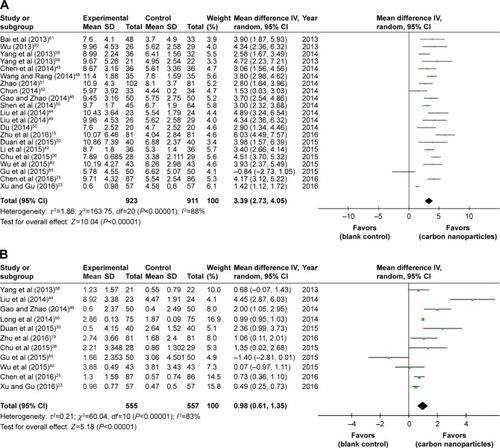
Figure 5 Forest plot showing the relationship of CNs and different kinds of retrieved lymph nodes.
Abbreviations: CN, carbon nanoparticle; M–H, Mantel–Haenszel; random, random effect; CI, confidence interval; df, degrees of freedom.
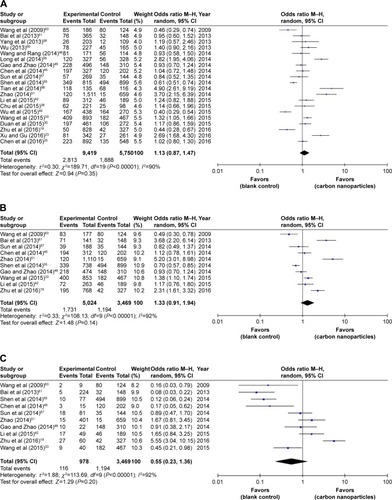
In the present meta-analysis of these studies, we found that the number of retrieved lymph nodes per patient in the CN group was higher than that of the blank control group. This finding of an increasing number of retrieved lymph nodes corresponds to the improvement in the extent of neck dissection. Further, with increasing removal of dyed lymph nodes, metastatic lymph nodes will also be cleared away simultaneously. Hence, the number of metastatic lymph nodes in the CN group was statistically higher than that in the blank control group. Besides, 4 studies reported that the number of retrieved small lymph nodes (diameter <5 mm) was significantly higher in the CN group.Citation44,Citation60,Citation61,Citation67 These findings suggest that CNs may help identify tiny, suspicious lymph nodes.
However, it should be noted that the total metastatic rate of the retrieved lymph nodes and the metastatic rate of stained or unstained lymph nodes did not significantly differ between the 2 groups, consistent with the findings of previous studies.Citation46,Citation68 In Gao and Zhao study,Citation46 more metastatic lymph nodes were eliminated in the CN group (6±2.37 vs 4±2.49; P<0.01), but the rate of metastatic lymph nodes did not differ (45.97% vs 47.10%; P>0.05). In the study by Yan et al,Citation68 no increase in the number of sentinel lymph node metastasis-positive cases was observed with the utilization of CNs, as compared to that in the control group (36.8% vs 63.2%). Concerning the mechanism of CNs, it is considered that the tissue damage and inflammation caused by the tumor alter the lymphatic drainage channels of the thyroid, which in turn will affect the diffusion of CNs and the identification of metastatic lymph nodes. Thus, it is actually quite hard for CNs to distinguish metastatic lymph nodes among normal lymph nodes.
Anatomic structure and physical function of the parathyroid in the CN and blank control groups
Compared with the blank control group, the use of CNs was associated with a lower rate of accidental parathyroid removal, approximately 22% (OR =0.22, 95% CI =0.16–0.30, P<0.00001; RD =−0.13, 95% CI =−0.15 to −0.11, P<0.00001; ). The transient and permanent hypoparathyroidism rates declined by approximately 31% and 24% in the CN group, respectively (transient hypoparathyroidism rate: OR =0.31, 95% CI =0.25–0.39, P<0.00001; RD =−0.15, 95% CI =−0.18 to −0.12, P<0.00001; ; permanent hypoparathyroidism rate: OR =0.24, 95% CI =0.07–0.85, P=0.03; RD =−0.02, 95% CI =−0.03 to −0.00, P<0.02; ). In addition, the rate of postoperative transient hypocalcemia in the blank control group was 30% higher than in the CN group (OR =0.30, 95% CI =0.25–0.38, P<0.00001; RD =−0.16, 95% CI =−0.18 to −0.13, P<0.00001; ). On the other hand, the postoperative permanent hypocalcemia rate did not significantly differ between the CN and blank control groups (OR =0.33, 95% CI =0.04–3.03, P=0.33; RD =−0.01, 95% CI =−0.03 to −0.01, P=0.35; ).
Figure 6 Accidental parathyroid removal rate in the CN and blank control groups.
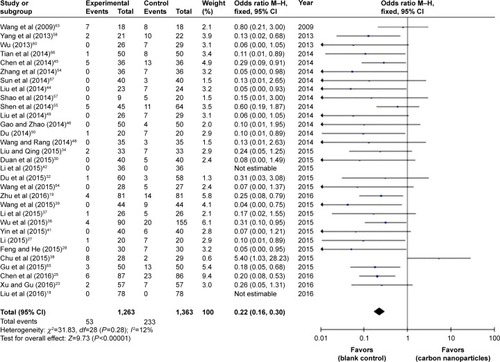
Figure 7 (A) Postoperative transient and (B) permanent hypoparathyroidism rates in the CN and blank control groups.
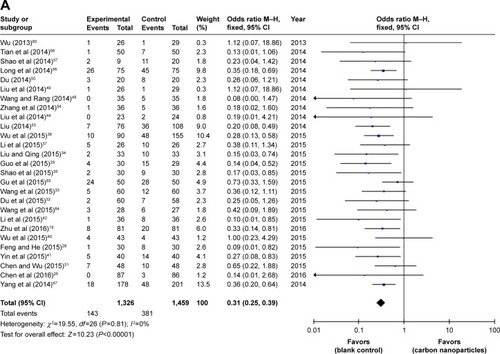
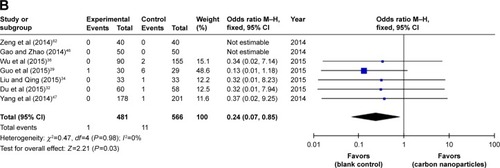
Figure 8 (A) Postoperative transient and (B) permanent hypocalcemia rates in the CN and blank control groups.
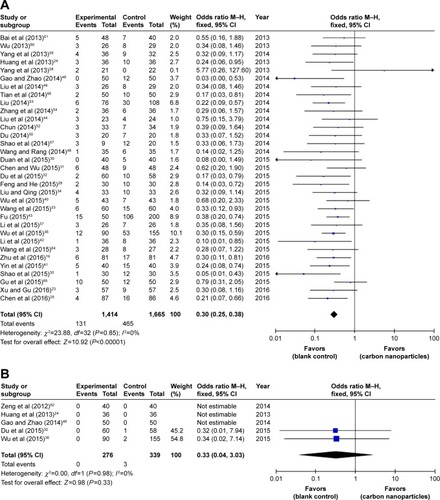
In terms of the protection of the parathyroid, some previous studies showed that the usage of CNs was not beneficial;Citation18,Citation24 however, our study demonstrated that the rates of accidental parathyroid removal (), postoperative transient or permanent hypoparathyroidism (), and transient hypocalcemia () were lower in the CN group. This finding suggests that the usage of CNs will help distinguish and preserve the parathyroid glands. However, there was no significant difference in the rate of permanent hypocalcemia. This might have resulted from the quantitative restrictions of the RCTs included. In addition, Yang et al reported that the use of CNs resulted in a decreased rate of parathyroid auto-transplantation.Citation47
Publication bias and limitations
A funnel plot analysis of all RCTs was performed as part of the present meta-analysis. The findings indicated that the publication bias was low (). But considering the difficulties in publishing studies with negative findings, many studies likely remain unpublished, and these were not available for analysis. In addition, the quality of assessment scores of the 47 RCTs included was relatively low, owing largely to a lack of blinding; however, it is difficult to apply double-blinding during surgery. Thus, further high-quality research is needed to verify the conclusions of the present study.
Figure 9 Funnel plots for publication bias.
Abbreviations: CN, carbon nanoparticle; SE, standard error; MD, mean difference; OR, odds ratio.
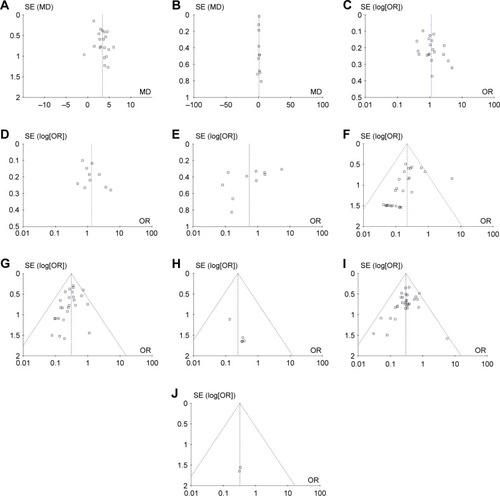
Conclusion
This systematic review and meta-analysis demonstrated that the usage of CNs can improve the extent of neck dissection and preserve the normal anatomic structure and physiological function of the parathyroid. At the same time, the number of retrieved metastatic lymph nodes can also be improved during thyroid cancer surgery.
Disclosure
The authors report no conflicts of interest in this work.
References
- ChenAYJemalAWardEMIncreasing incidence of differentiated thyroid cancer in the United States, 1988–2005Cancer2009115163801380719598221
- La VecchiaCMalvezziMBosettiCThyroid cancer mortality and incidence: a global overviewInt J Cancer201513692187219525284703
- BritoJPHayIDMorrisJCLow risk papillary thyroid cancerBMJ2014348g304524935445
- MarkovinaSGrigsbyPWSchwarzJKTreatment approach, surveillance, and outcome of well-differentiated thyroid cancer in childhood and adolescenceThyroid20142471121112624731094
- OroscoRKLinHWBhattacharyyaNAmbulatory thyroidectomy: a multistate study of revisits and complicationsOtolaryngol Head Neck Surg201515261017102325829390
- PodnosYDSmithDWagmanLDEllenhornJDThe implication of lymph node metastasis on survival in patients with well-differentiated thyroid cancerAm Surg200571973173416468507
- ZaydfudimVFeurerIDGriffinMRPhayJEThe impact of lymph node involvement on survival in patients with papillary and follicular thyroid carcinomaSurgery2008144610701077 discussion 1077–107819041020
- ZhuXLiJHeHHuangMZhangXWangSApplication of nanomaterials in the bioanalytical detection of disease-related genesBiosens Bioelectron20157411313326134290
- KonvalinaGHaickHSensors for breath testing: from nanomaterials to comprehensive disease detectionAcc Chem Res2014471667623926883
- IslamTHarisinghaniMGOverview of nanoparticle use in cancer imagingCancer Biomark200952616719414922
- PengFSuYZhongYFanCLeeSTHeYSilicon nanomaterials platform for bioimaging, biosensing, and cancer therapyAcc Chem Res201447261262324397270
- YezhelyevMVGaoXXingYAl-HajjANieSO’ReganRMEmerging use of nanoparticles in diagnosis and treatment of breast cancerLancet Oncol20067865766716887483
- LiuZLiuJWangRDuYRenJQuXAn efficient nano-based theranostic system for multi-modal imaging-guided photothermal sterilization in gastrointestinal tractBiomaterials20155620621825934293
- GismondiANanniVReinaGOrlanducciSTerranovaMLCaniniANanodiamonds coupled with 5,7-dimethoxycoumarin, a plant bioactive metabolite, interfere with the mitotic process in B16F10 cells altering the actin organizationInt J Nanomedicine20161155757426893562
- GismondiAReinaGOrlanducciSNanodiamonds coupled with plant bioactive metabolites: a nanotech approach for cancer therapyBiomaterials201538223525457980
- DavisMEChenZGShinDMNanoparticle therapeutics: an emerging treatment modality for cancerNat Rev Drug Discov20087977178218758474
- YanamalaNKaganVEShvedovaAAMolecular modeling in structural nano-toxicology: interactions of nanoparticles with nano-machinery of cellsAdv Drug Deliv Rev201365152070207723726945
- LiuXChangSJiangXHuangPYuanZIdentifying parathyroid glands with carbon nanoparticle suspension does not help protect parathyroid function in thyroid surgery: a prospective, randomized control clinical studySurg Innov201623438138926783268
- ZhuYChenXZhangHCarbon nanoparticle-guided central lymph node dissection in clinically node-negative patients with papillary thyroid carcinomaHead Neck201638684084525832013
- LiYJianWHGuoZMLiQLLinSJHuangHYA meta-analysis of carbon nanoparticles for identifying lymph nodes and protecting parathyroid glands during surgeryOtolaryngol Head Neck Surg201515261007101625897006
- YoussefTGaballahGAbd-ElaalEEl-DosokyEAssessment of risk factors of incidental parathyroidectomy during thyroid surgery: a prospective studyInt J Surg20108320721120060940
- KurmannAHerdenUSchmidSWCandinasDSeilerCAMorbidity rate of reoperation in thyroid surgery: a different point of viewSwiss Med Wkly2012142w1364322893523
- XuXFGuJThe application of carbon nanoparticles in the lymph node biopsy of cN0 papillary thyroid carcinoma: a randomized controlled clinical trialAsian J Surg Epub2016115
- HuangKLuoDHuangMLongMPengXLiHProtection of parathyroid function using carbon nanoparticles during thyroid surgeryOtolaryngol Head Neck Surg2013149684585024163324
- ChenZLChenGYFanHLClinical research on the identification and protection effects of nano carbon particles on parathyroid gland in thyroid carcinoma surgeryJ Beihua Univ Nat Sci20161718991
- ZhangJZhangYQZhangAMProtective effect of nano-carbon on parathyroid gland during thyroidActa Acad Med Weifang20163817072
- LiDJApplication value of nano carbon for the protection of parthyroid in thyroid carcinoma surgeryChin J Mod Drug Appl2015935051
- FengLFHeZValue of carbon nanoparticles in the surgery of thyroid carcinomaJ Basic Clin Oncol20152813940
- GuoMZhangHLiWHGaoJLYangJThe protection of the parathyroid and recurrent laryngeal nerve by carbon nanoparticles in cN0 phase thyroidectomyChina Med Eng2015234169171
- DuanXWLiZLXuJApplication of carbon nanoparticle tracer in radical neck dissection for thyroid cancerChin J Gen Surg2015245638642
- ChenSHWuZYThe effection of lymph node tracer in central neck dissection and thyroidectomyChin J Gen Surg2015245760763
- DuGNXiaoYGTanYHApplication of nano-carbon parathyroid negative imaging technique to radical thyroidectomy for thyroid cancerJ Chin Oncol2015216469471
- WangWHangBLinPResearch on the feasibility and significance of Delphian lymph node labeling by nanometer carbon in thyroid cancer surgeryMMJC2015177710
- LiuJWQingXYThe usage of carbon nanopartciles in preserving parathyroid and the value in thyroidectomyGuide China Med20151325124125
- ShaoYZhaoMRBaiYXThe application of the nano-carbon tracer in 30 cases of thyroid gland carcinoma operationMod Oncol2015232029152917
- WuHSXiaoYZhengCWangXMApplication of negative stained parathyroid in thyroid carcinoma surgery by using carbon nanoparticlesShenzhen J Integr Trad Chin West Med2015251869
- LiXTLinYDaiPAiQBZhangGRClinical study of avoiding intraoperative parathyroid cut by mistake or function impairmentChina Mod Med201522292628
- ChuHDJiangLXZhengHTActivated carbon nanoparticle in dissection of central lymph nodes of papillary thyroid carcinomas: a control studyChin J Oper Proc Gen Surg (Electronic Edition)2015955759
- WangLPLiuCSLuoXYApplication value of nano carbon for the protection of parathyroid glands in thyroid carcinoma surgeryZhong Guo She Qu Yi Sheng201531323133
- WuGCaiLHuJRole of carbon nanoparticles in patients with thyroid carcinoma undergoing total thyroidectomy plus bilateral central neck dissectionZhonghua Yi Xue Za Zhi20159512912916 Chinese [with English abstract]26081053
- YinFYXinHZhangXJProtective effects of nano-carbon on parathyroid in thyroid surgeryChin J Endocr Surg201592144146
- LiHQYinDTWangYFCarbon nanoparticles in central lymph node dissection in treatment of papillary thyroid carcinomaChin J Endocr Surg201595398400
- FuKThe Comparison of Different Methods in Protecting Parathyroid Gland and Clinical Significant [dissertation]ShijiazhuangHebei Medical University2015
- LiuXLHanBWuWWSunDSWeiWExperience of preoperative ultrasound guided carbon nanoparticles thyroid injection in thyroid carcinoma surgery: an analysis of 47 casesZhong Guo Shi Yong Wai Ke Za Zhi201434Suppl 179
- ChenWLvYXieRXuDYuJApplication of lymphatic mapping to recognize and protect parathyroid in thyroid carcinoma surgery by using carbon nanoparticlesLin Chung Er Bi Yan Hou Tou Jing Wai Ke Za Zhi20142824191819201924 Chinese [with English abstract]25895304
- GaoQZhaoDClinical application of carbon nanoparticles labeled lymph node in cervical lymph node dissection with papillary thyroid cancer staged preoperatively as N0Lin Chung Er Bi Yan Hou Tou Jing Wai Ke Za Zhi2014282419381940 Chinese [with English abstract]25895310
- YangJFLiHHuBThe protection of carbon nanoparticles for parathyroid gland in total thyroidectomy and central lymph dissectionJ Clin Otorhinolaryngol Head Neck Surg (China)2014281813821384
- WangJWRangCFProtective effects of carbon nanoparticles on parathyroid in thyroid surgeryMedical Journal of National Defending Forces in Southwest China2014246609612
- LiuNHanBWeiWApplication of carbon nanoparticles in thyroid cancer surgeryGuangdong Med J2014351219181920
- DuJClinical Research of Carbon Nano Lymph Tracer on Parathyroid Protective Effect in Operation of Thyroid Carcinoma [dissertation]DalianDalian Medical University2014
- ZhaoBCarbon Nanoparticles Tracer in the Early Thyroid Papillary Carcinoma Clinical Studies of Surgical Treatment [dissertation]KunmingKunming Medical University2014
- ChunLThe Applied Significance of Carbon Nanoparticles in Surgery of Papillary Thyroid Microcarcinoma [dissertation]ChongqingChongqing Medical University2014
- LiuZFResearch on Nano-Carbon Protection of Parathyroid Glands in Operation of Thyroid Carcinoma [dissertation]QingdaoShandong University2014
- ZhangQZhangQDengLFProtective effects of carbon nanoparticles on parathyroid gland during thyroidectomyChin J Prim Med Pharm2014212234083409
- ShenHWeiBFengSZhouQEfficiency of carbon nanoparticles in level VI lymphadenectomy for thyroid carcinoma and prevention of postoperative hypoparathyroidismZhonghua Er Bi Yan Hou Tou Jing Wai Ke Za Zhi20144910817820 Chinese [with English abstract]25567436
- LongMYLongHYHuangMQActivated nano carbon in prophylactic central lymph node dissection of T1 papillary thyroid non-microcarcinomaChin J Endocr Surg201485422424
- ShaoQZouRLShanHLApplication of carbon nanoparticles during thyroid surgeryJ Clin Med Pract20141823435
- YangXHWangYWangPApplication of carbon nanoparticle in endoscopic surgery of thyroid carcinomaJ Laparosc Surg2013184262265
- YangZFYueRXZhuZThe applied significance of carbon nanoparticles in central compartment lymph node dissection in treatment of cN0 papillary thyroid carcinomaChin J Bases Clin Gen Surg2013209976980
- WuWWThe Significance of Applying Preoperative Ultrasound Guided Carbon Nanoparticles Injection in Thyroid Cancer Surgery [dissertation]ShantouShantou University2013
- BaiYCZhangJMSuYJDiaoCQianJChenRCRole of lymphatic tracers in lymph node dissection and pathological examination of papillary thyroid carcinomaChin J Clin Oncol2013401710341037
- ZengYJQianJChenRCProtective effect of lymphatic tracer on parathyroid glands in lymph node dissection in thyroid carcinomaChongqing Med J2012411110761088
- WangXLWuYHXuZGNiSLiuJParathyroid glands are differentiated from lymph node by activated-carbon particlesZhonghua Er Bi Yan Hou Tou Jing Wai Ke Za Zhi2009442136140 Chinese [with English abstract]19558888
- WangBQiuNZhangWThe role of carbon nanoparticles in identifying lymph nodes and preserving parathyroid in total endoscopic surgery of thyroid carcinomaSurg Endosc201529102914292025761552
- GuJLWangJFNieXLWangWDShangJBPotential role for carbon nanoparticles identification and preservation in situ of parathyroid glands during total thyroidectomy and central compartment node dissectionInt J Clin Exp Med2015869640964826309638
- TianWJiangYGaoBApplication of nano-carbon in lymph node dissection for thyroid cancer and protection of parathyroid glandsMed Sci Monit2014201925193025311844
- SunSPZhangYCuiZQClinical application of carbon nanoparticle lymph node tracer in the VI region lymph node dissection of differentiated thyroid cancerGenet Mol Res20141323432343724841788
- YanXZengRCMaZThe utility of sentinel lymph node biopsy in papillary thyroid carcinoma with occult lymph nodesPLoS One2015106e129304

